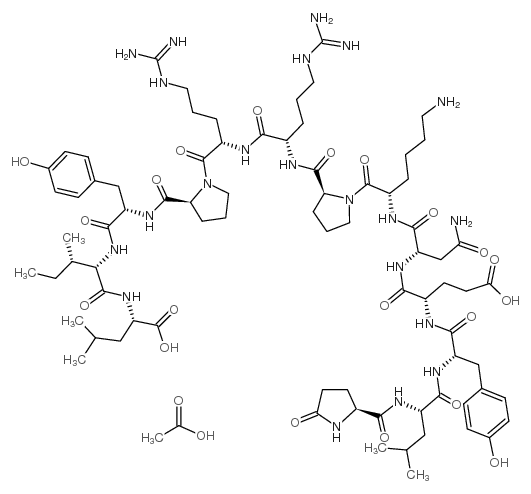Neurotensin

Neurotensin structure
|
Common Name | Neurotensin | ||
|---|---|---|---|---|
| CAS Number | 58889-67-1 | Molecular Weight | 1732.98000 | |
| Density | N/A | Boiling Point | N/A | |
| Molecular Formula | C80H125N21O22 | Melting Point | N/A | |
| MSDS | Chinese USA | Flash Point | N/A | |
|
Unbiased classification of sensory neuron types by large-scale single-cell RNA sequencing.
Nat. Neurosci. 18(1) , 145-53, (2015) The primary sensory system requires the integrated function of multiple cell types, although its full complexity remains unclear. We used comprehensive transcriptome analysis of 622 single mouse neurons to classify them in an unbiased manner, independent of a... |
|
|
Neuropeptide Y family-degrading metallopeptidases in the Tityus serrulatus venom partially blocked by commercial antivenoms.
Toxicol. Sci. 142(2) , 418-26, (2014) Accidents caused by scorpions represent a relevant public health issue in Brazil, being more recurring than incidents with snakes and spiders. The main species responsible for this situation is the yellow scorpion, Tityus serrulatus, due especially to the gre... |
|
|
Expression and colocalization patterns of calbindin-D28k, calretinin and parvalbumin in the rat hypothalamic arcuate nucleus.
J. Chem. Neuroanat. 61-62 , 20-32, (2014) Calcium binding proteins (CaBPs) form a diverse group of molecules that function as signal transducers or as intracellular buffers of Ca(2+) concentration. They have been extensively used to histochemically categorize cell types throughout the brain. One regi... |
|
|
The potential of neurotensin secreted from neuroendocrine tumor cells to promote gelsolin-mediated invasiveness of prostate adenocarcinoma cells.
Lab. Invest. 95(3) , 283-95, (2015) Neuroendocrine (NE) cells in prostate cancer have been shown to be associated with the progression of prostate cancer. However, little is known about the molecular basis of this association. We have previously demonstrated that NE cells promote metastasis of ... |
|
|
Transient transfection of human CDNF gene reduces the 6-hydroxydopamine-induced neuroinflammation in the rat substantia nigra.
J. Neuroinflammation 11 , 209, (2015) The anti-inflammatory effect of the cerebral dopamine neurotrophic factor (CDNF) was shown recently in primary glial cell cultures, yet such effect remains unknown both in vivo and in 6-hydroxydopamine (6-OHDA) models of Parkinson's disease (PD). We addressed... |
|
|
A transcriptomal analysis of bovine oviductal epithelial cells collected during the follicular phase versus the luteal phase of the estrous cycle.
Reprod. Biol. Endocrinol. 13 , 84, (2015) Reproductive success depends on a functional oviduct for gamete storage, maturation, fertilization, and early embryonic development. The ovarian-derived steroids estrogen and progesterone are key regulators of oviductal function. The objective of this study w... |
|
|
Prolyl Oligopeptidase from the Blood Fluke Schistosoma mansoni: From Functional Analysis to Anti-schistosomal Inhibitors.
PLoS Negl. Trop. Dis. 9 , e0003827, (2015) Blood flukes of the genus Schistosoma cause schistosomiasis, a parasitic disease that infects over 240 million people worldwide, and for which there is a need to identify new targets for chemotherapeutic interventions. Our research is focused on Schistosoma m... |
|
|
The quetiapine active metabolite N-desalkylquetiapine and the neurotensin NTS₁ receptor agonist PD149163 exhibit antidepressant-like effects on operant responding in male rats.
Exp. Clin. Psychopharmacol. 22(6) , 548-56, (2014) Major depressive disorder is the most common mood disorder in the United States and European Union; however, the limitations of clinically available antidepressant drugs have led researchers to pursue novel pharmacological treatments. Clinical studies have re... |
|
|
Activation of EGFR, HER2 and HER3 by neurotensin/neurotensin receptor 1 renders breast tumors aggressive yet highly responsive to lapatinib and metformin in mice.
Oncotarget 5(18) , 8235-51, (2014) A present challenge in breast oncology research is to identify therapeutical targets which could impact tumor progression. Neurotensin (NTS) and its high affinity receptor (NTSR1) are up regulated in 20% of breast cancers, and NTSR1 overexpression was shown t... |
|
|
Role of LPAR3, PKC and EGFR in LPA-induced cell migration in oral squamous carcinoma cells.
BMC Cancer 14 , 432, (2014) Oral squamous cell carcinoma is an aggressive neoplasm with serious morbidity and mortality, which typically spreads through local invasive growth. Lysophosphatidic acid (LPA) is involved in a number of biological processes, and may have a role in cancer cell... |